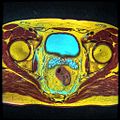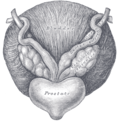Seminal vesicles
Seminal vesicles are a pair of glands found in male mammals that produce a significant proportion of the fluid that ultimately becomes semen. They are located posterior to the urinary bladder and above the prostate gland. The seminal vesicles secrete a fluid that is rich in fructose, which provides the sperm with a source of energy that aids in their motility. The fluid also contains prostaglandins, which assist in the successful fertilization of the ovum by the sperm.
Anatomy[edit]
The seminal vesicles are a pair of tubular structures approximately 5 cm in length, though this can vary. They are located within the pelvic cavity, posterior to the urinary bladder and above the prostate gland. Each seminal vesicle consists of a single, coiled tube that is lined with secretory cells and surrounded by smooth muscle.
Function[edit]
The primary function of the seminal vesicles is the production of seminal fluid. This fluid makes up approximately 70% of the total volume of semen. The fluid produced by the seminal vesicles is rich in fructose, which provides the sperm with a source of energy that aids in their motility. The fluid also contains prostaglandins, which assist in the successful fertilization of the ovum by the sperm.
In addition to providing energy and aiding in fertilization, the seminal fluid also helps to protect the sperm from the acidic environment of the female reproductive tract. The fluid has an alkaline pH, which helps to neutralize the acidity of the female reproductive tract and increase the lifespan of the sperm.
Clinical significance[edit]
Diseases and conditions that can affect the seminal vesicles include vesiculitis, which is inflammation of the seminal vesicles, and cancer. Vesiculitis can cause pain and fertility problems, while cancer of the seminal vesicles is rare but can be serious.
See also[edit]
-
Male anatomy 1
-
Gray's Anatomy 1160
-
Histology of seminal vesicle glands on H&E stain
-
Seminal vesicle low magnification
-
Seminal vesicle high magnification
-
Pelvic MRI T1FSE T2frFSE T2FSfrFSE 11
-
Seminal vesicles
-
Gray's Anatomy 1152
Ad. Transform your life with W8MD's Budget GLP-1 injections from $75


W8MD offers a medical weight loss program to lose weight in Philadelphia. Our physician-supervised medical weight loss provides:
- Weight loss injections in NYC (generic and brand names):
- Zepbound / Mounjaro, Wegovy / Ozempic, Saxenda
- Most insurances accepted or discounted self-pay rates. We will obtain insurance prior authorizations if needed.
- Generic GLP1 weight loss injections from $75 for the starting dose.
- Also offer prescription weight loss medications including Phentermine, Qsymia, Diethylpropion, Contrave etc.
NYC weight loss doctor appointmentsNYC weight loss doctor appointments
Start your NYC weight loss journey today at our NYC medical weight loss and Philadelphia medical weight loss clinics.
- Call 718-946-5500 to lose weight in NYC or for medical weight loss in Philadelphia 215-676-2334.
- Tags:NYC medical weight loss, Philadelphia lose weight Zepbound NYC, Budget GLP1 weight loss injections, Wegovy Philadelphia, Wegovy NYC, Philadelphia medical weight loss, Brookly weight loss and Wegovy NYC
|
WikiMD's Wellness Encyclopedia |
| Let Food Be Thy Medicine Medicine Thy Food - Hippocrates |
Medical Disclaimer: WikiMD is not a substitute for professional medical advice. The information on WikiMD is provided as an information resource only, may be incorrect, outdated or misleading, and is not to be used or relied on for any diagnostic or treatment purposes. Please consult your health care provider before making any healthcare decisions or for guidance about a specific medical condition. WikiMD expressly disclaims responsibility, and shall have no liability, for any damages, loss, injury, or liability whatsoever suffered as a result of your reliance on the information contained in this site. By visiting this site you agree to the foregoing terms and conditions, which may from time to time be changed or supplemented by WikiMD. If you do not agree to the foregoing terms and conditions, you should not enter or use this site. See full disclaimer.
Credits:Most images are courtesy of Wikimedia commons, and templates, categories Wikipedia, licensed under CC BY SA or similar.
Translate this page: - East Asian
中文,
日本,
한국어,
South Asian
हिन्दी,
தமிழ்,
తెలుగు,
Urdu,
ಕನ್ನಡ,
Southeast Asian
Indonesian,
Vietnamese,
Thai,
မြန်မာဘာသာ,
বাংলা
European
español,
Deutsch,
français,
Greek,
português do Brasil,
polski,
română,
русский,
Nederlands,
norsk,
svenska,
suomi,
Italian
Middle Eastern & African
عربى,
Turkish,
Persian,
Hebrew,
Afrikaans,
isiZulu,
Kiswahili,
Other
Bulgarian,
Hungarian,
Czech,
Swedish,
മലയാളം,
मराठी,
ਪੰਜਾਬੀ,
ગુજરાતી,
Portuguese,
Ukrainian








